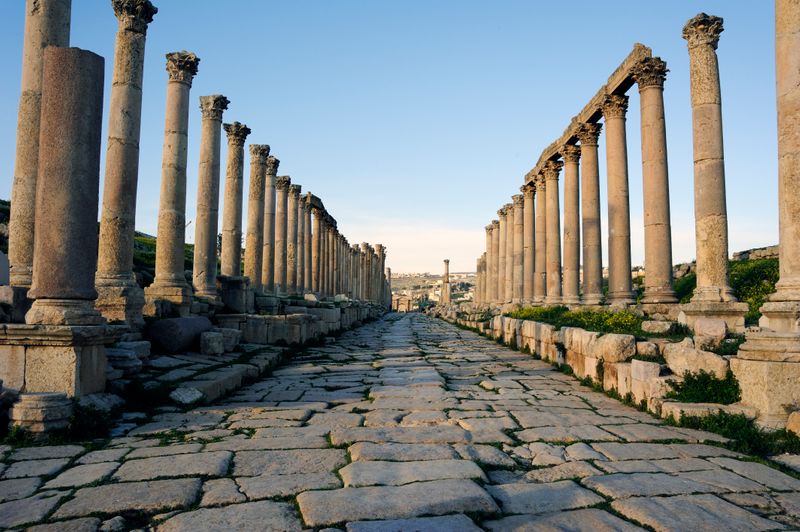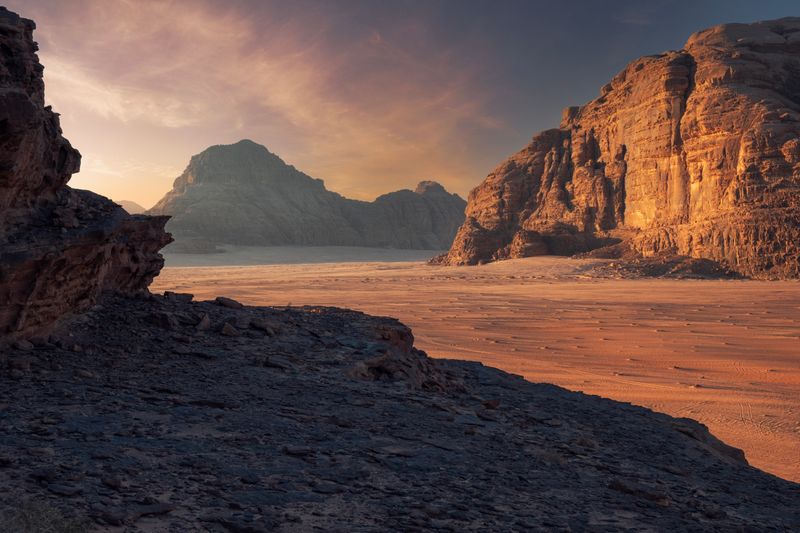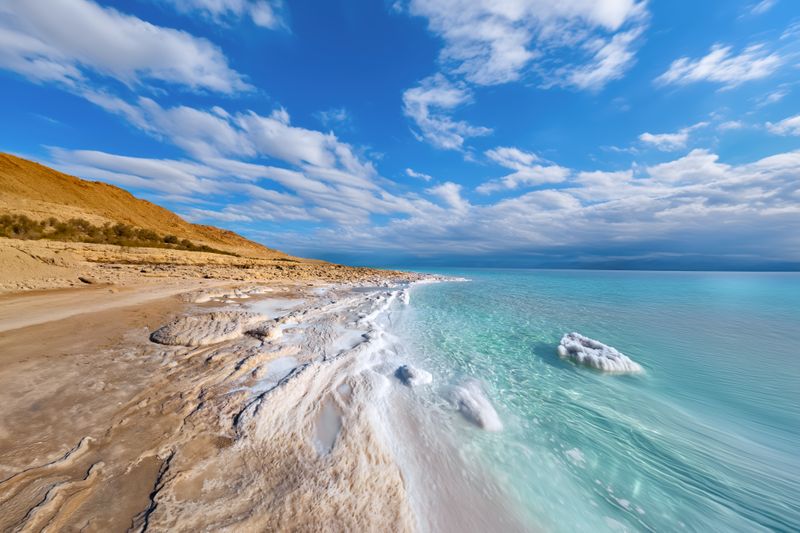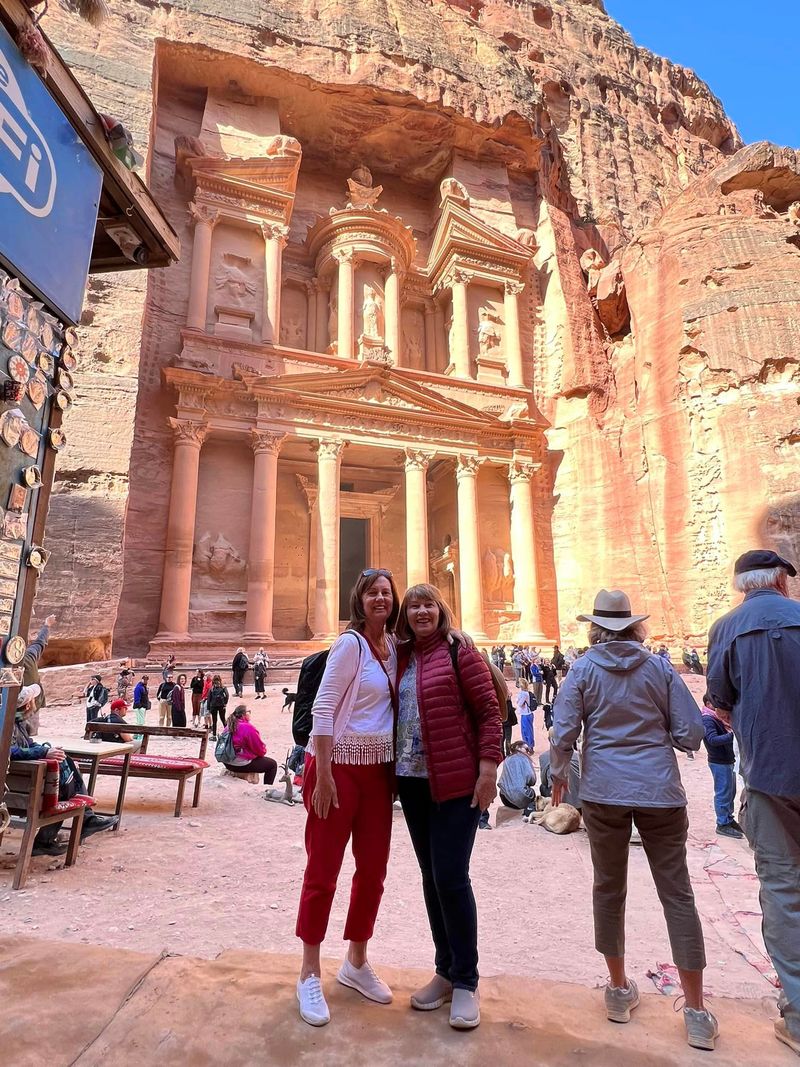Scattered across deserts, valleys, and ancient trade routes, the Jordan ruins stand as timeless reminders of the empires and cultures that shaped this land. From Roman colonnades and Islamic fortresses to Nabataean tombs carved deep into rose-red cliffs, each site reveals a chapter of history written over thousands of years. This Jordan travel guide for history lovers explores the best archaeological sites in Jordan and what makes them essential stops on your itinerary.
Fast facts on Jordan
- UNESCO sites: Jordan has 6, including Petra, Wadi Rum, and Umm ar-Rasas
- Roman legacy: Jerash is among the best-preserved Roman cities outside Europe
- Petra's age: Nabataean capital established more than 2,000 years ago
- Lowest point on Earth: The Dead Sea sits at -430m below sea level
- Historic layers: Crusader castles, Islamic forts, Byzantine mosaics, and prehistoric relics
- Best time to visit: Spring (Mar–May) and autumn (Sep–Nov) offer pleasant weather
Why Jordan is a dream for history lovers
Jordan is one of the richest archaeological landscapes in the world. Its compact size hides a staggering diversity of historical places to see in Jordan, spanning empires, religions, and civilisations. From the Nabataeans and Romans to the Byzantines and early Muslims, the stories embedded in Jordan’s landmarks run deep.
It’s not just the scale or beauty of these ruins that leave a mark. It’s the way you can walk right through them. No velvet ropes, no sterile glass cases. Just sun-warmed stones, desert wind, and the feeling that time is folding in on itself.
Jerash and beyond
Jerash is one of the top archaeological sites in Jordan and a dream for Roman history fans. Known in ancient times as Gerasa, it was conquered by Emperor Pompey in 63 BC. Today, it remains one of the best-preserved Roman ruins in Jordan and is among the best-preserved Roman cities outside Europe..
Stroll through Hadrian’s Arch, built to honour the emperor’s visit in AD 129. From there, take in the Oval Plaza, Temple of Artemis, South Theatre and Nymphaeum Fountain. You might even catch the Roman Army and Chariot Experience, which brings Jerash ruins to life with staged gladiator battles and racing chariots.
For a fuller day, venture into the hills around Jerash. Nearby Ajloun Castle offers sweeping views and Crusader-era relics surrounded by olive groves, pine forests and fig trees.
Petra, the rose city
No list of ancient sites in Jordan is complete without Petra. Carved into the cliffs more than 2,000 years ago, the ruins of Petra in Jordan are what remain of the Nabataean capital. Petra’s history is long and layered, blending nomadic, Arabic and Greco-Roman influence. Today, it is a UNESCO World Heritage Site and one of the best ancient ruins to visit in Jordan.
Famous for the intricate facade of Al-Khazneh (The Treasury), Petra is much larger than most expect. Don’t miss:
- The Royal Tombs
- The Street of Facades
- The Petra Amphitheatre
- Qasr al-Bint
- The Monastery (Ad-Deir), reached by climbing 800+ steps
- The High Place of Sacrifice
Petra ruins are best explored early in the morning before the heat and crowds build. Good walking shoes and plenty of water are essential. For a magical experience, consider Petra by Night, when the Siq and Treasury are lit with thousands of candles and accompanied by traditional music.
Wadi Rum
Wadi Rum is one of the most visually striking desert ruins in Jordan. Its rust-red sand, natural rock bridges and towering cliffs have appeared in films like The Martian and Lawrence of Arabia. But beneath the surface, Wadi Rum history runs deep.
Petroglyphs, Nabataean inscriptions, and desert carvings document millennia of trade and travel. These desert relics offer insight into nomadic life and early religious beliefs.
Top sites in Wadi Rum include:
- Anfashieh Inscriptions
- Nabataean Temple near Rum Village
- Lawrence’s Spring and House
Wadi Rum is best explored with a local guide via 4WD or camel. You can stay in a Bedouin camp, try glamping in Martian-style domes, or book activities like rock climbing and hot air ballooning.
The Dead Sea
While the Dead Sea is more a natural wonder than an archaeological site, its history is deeply intertwined with that of the Jordan Valley, making it a worthy addition to any itinerary exploring the Jordan ruins. Shared with Israel and the Palestinian Territories, it is the lowest body of water on Earth and among the saltiest.
Historically known for its healing mud and minerals, the Dead Sea, at -430m, is the lowest point on Earth’s land surface. Its hyper-saline waters make floating effortless, a surreal experience framed by the surrounding desert mountains. Since ancient times, its mineral-rich mud has been prized for therapeutic and cosmetic uses—Cleopatra herself is said to have sought its beauty benefits.
Travel tip: Bring sandals and fresh water to rinse off after floating. The salt crystals are sharp, and the water can sting.
Crusader Castles in Jordan
Crusader castles in Jordan are important relics of medieval conflict between Christian crusaders and Muslim rulers. The most famous is Kerak Castle, a vast 12th-century fortification perched above a steep valley. It survived multiple sieges, including one led by Saladin.
Nearby Shobak Castle, also known as Montreal, contains traces of its Crusader past, including stone churches, Arabic inscriptions, and a Mamluk watchtower. These historical places in Jordan offer a raw and rugged counterpoint to the more polished Roman ruins.
Mosaics in Madaba
Madaba is famous for its Byzantine mosaics and is one of the more underrated Jordan tourist sites. The most well-known is the 6th-century mosaic map of the Holy Land inside St George’s Church. It is the oldest known geographic floor mosaic in existence.
The Madaba Archaeological Park is also worth a visit, with remains of ancient homes, roads and churches. You’ll also find Roman ruins and more religious relics embedded under the city.
Umm ar-Rasas
Umm ar-Rasas is one of the top ancient sites in Jordan for lovers of layered history. Listed as a UNESCO-listed archaeological site since 2004, it contains relics from Roman, Byzantine and early Islamic periods.
The most notable features include sixteen early Christian churches and the famous stylite tower used by ascetic monks. If you’re wondering where to see ancient artifacts in Jordan without the crowds, this is a must.
When is the best time to visit Jordan's ruins
Jordan is a year-round destination, but if you're planning to explore ancient ruins, timing matters. Spring (March to May) is one of the best times to visit, when the weather is warm but not overwhelming, and the landscapes are lush with wildflowers. Autumn (September to November) offers similarly pleasant conditions, especially for exploring Petra and Jerash on foot. Summer can be very hot, particularly in the south, while winter brings cooler temperatures and occasional rain.
For more insider tips about travel in Jordan, check out our article on the best time to visit Jordan.
Getting around Jordan's archaeological sites
Travelling between Jordan’s archaeological sites is simple when you book with Inspiring Vacations. All our Jordan tours include airport transfers, modern air-conditioned coaches, and English-speaking tour guides to make your experience as seamless as possible. You'll move comfortably between key locations like Amman, Petra, Jerash, Wadi Rum, and the Dead Sea, without having to worry about local transport or navigating unfamiliar roads.
For those travelling independently, hiring a private driver or rental car is possible, but not essential when booking a guided itinerary. Public transport options are limited and not well connected to historical sites, especially in more remote areas. Our tours are designed to take the stress out of logistics so you can focus on soaking in Jordan’s spectacular ruins.
What to wear and bring when visiting ruins
Comfort and practicality are key. Sturdy shoes are a must for uneven terrain in Petra, Jerash and Umm ar-Rasas. Lightweight, breathable clothing will help you stay cool under the sun, and a hat and sunscreen are essential. Pack a refillable water bottle and consider bringing a travel scarf or shawl, useful for modesty when visiting religious sites or rural areas.
Here’s our packing list checklist:
- Comfortable walking shoes with good grip
- Lightweight, breathable clothing for daytime
- A light jacket for cooler evenings in spring and autumn
- Sunscreen, hat, and sunglasses
- Plenty of water and snacks for your longer site visits
- A camera or phone with extra storage for photos
Planning your Jordan Ruins adventure
Jordan is one of the best destinations for travellers who love history and archaeology. You can easily visit multiple Roman ruins, biblical sites and desert relics within one trip.
Key tips for visiting ancient ruins in Jordan:
- Start early: Beat the heat and get better photos
- Dress modestly and practically: Respect cultural norms while staying comfortable
- Go with a guide: You’ll learn more and navigate sites more easily
- Decide which regions to prioritise—northern Jordan for Roman ruins, southern Jordan for Petra and Wadi Rum
- Allow time to experience local culture alongside the archaeological highlights
- Balance major UNESCO sites with lesser-known gems to avoid crowd fatigue and discover hidden treasures
Experience the Jordan ruins with Inspiring Vacations
Want to walk the same streets as ancient traders, explorers, and emperors? Our Jordan tours are carefully designed to take you through the country's most iconic archaeological sites, from the breathtaking Treasury of Petra to the colonnaded streets of Jerash, the windswept desert relics of Wadi Rum, and more.
Led by expert local guides, our itineraries combine rich historical insights with comfortable travel and authentic experiences. You’ll see the highlights, uncover hidden gems, and gain a deeper understanding of Jordan’s layered past.
Explore our range of tours to Jordan, like the Jordan Uncovered Premium Small Group tour, to see what adventures are waiting for you with Inspiring Vacations.





